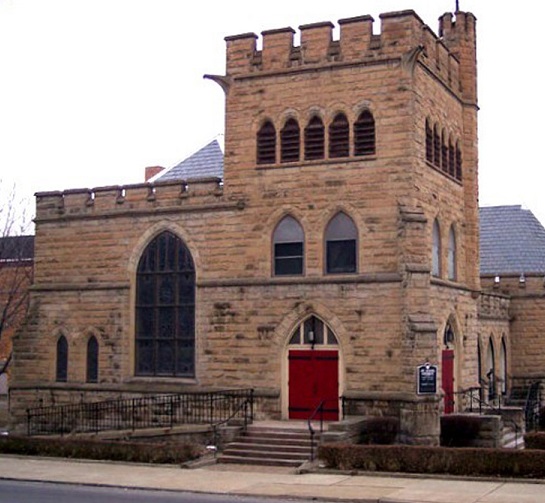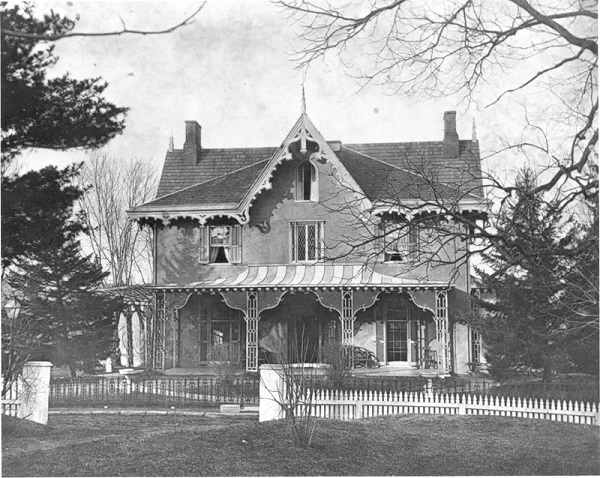Gothic revival style
The Gothic Revival style is part of the mid-19th century picturesque and romantic movement in architecture, reflecting the public's taste for buildings inspired by medieval design.
This was a real departure from the previously popular styles that drew inspiration from the classical forms of ancient Greece and Rome. While distinctly different, both the Gothic Revival style and the Greek Revival style looked to the past, and both remained popular throughout the mid 19th century.
This style was promoted as an appropriate design for rural settings, with its complex and irregular shapes and forms fitting well into the natural landscape. Thus, the Gothic Revival style was often chosen for country homes and houses in rural or small town settings, particularly in America.
The Gothic Revival style was also popular for churches, where high style elements such as castle-like towers, parapets, and tracery windows were common, as well as the pointed Gothic arched windows and entries.
The Carpenter Gothic style is a distinctive variation of Gothic Revival, featuring vertical board and batten wooden siding, pointed arches and incised wooden trim. The name comes from the extensive use of decorative wood elements on the exterior.
The most commonly identifiable feature of the Gothic Revival style is the pointed arch, used for windows, doors, and decorative elements like porches, dormers, or roof gables.
Other characteristic details include steeply pitched roofs and front-facing gables with delicate wooden trim called vergeboards or bargeboards. This distinctive incised wooden trim is often referred to as 'gingerbread' and is the feature most associated with this style.
Gothic Revival style buildings often have porches with decorative turned posts or slender columns, with flattened arches or side brackets connecting the posts. Gothic Revival style churches may have, not just pointed arch windows and porticos, but often feature a Norman castle-like tower with a crenellated parapet or a high spire.
Later in the 19th century, Gothic Revival details were mixed with elements of other Victorian-era styles to become a style known as the Victorian Gothic. In the early 20th century, a distinct variation of the Gothic Revival style, known as the Collegiate Gothic style, developed primarily for educational buildings.
--Pennsylvania Historical and Museum Commission
[edit] Related articles on Designing Buildings Wiki
- Architectural styles.
- Boss (medieval architecture).
- Classical revival style.
- Colonial Revival style.
- Crenellations.
- Crocket.
- Edwardian architecture.
- English Perpendicular architecture.
- Flèche.
- Gargoyle.
- Grotesque.
- Hunky punk.
- Italian Renaissance revival style.
- Machicolation.
- Monument and context.
- Nineteenth century building types.
- Oxford Movement.
- Palace of Westminster.
- Picturesque movement.
- Pinnacle.
- Queen Anne style.
- Regency style.
- Rose window.
- Rule of thumb.
- Stick style.
- Spanish Colonial revival style.
- Strawberry Hill House.
- Tudor revival style.
IHBC NewsBlog
Images from inside a Grade II listed hotel show the scale of its collapse
The Corbett Arms in Tywyn has fallen into serious disrepair.
Old Sarum fire in listed (& disputed) WW1 Hangar - Wiltshire Council has sought legal advice after fire engulfed a listed First World War hangar that was embroiled in a lengthy planning dispute.
UK Antarctic Heritage Trust launches ‘Virtual Visit’ website area
The Trust calls on people to 'Immerse yourself in our heritage – Making Antarctica Accessible'
Southend Council pledge to force Kursaal owners to maintain building
The Council has pledged to use ‘every tool in the toolbox’ if urgent repairs are not carried out.
HE’s Research Magazine publishes a major study of the heritage of England’s suburbs
The article traces the long evolution of an internal programme to research 200 years of suburban growth
IHBC Context 183 Wellbeing and Heritage published
The issue explores issues at the intersection of heritage and wellbeing.
SAVE celebrates 50 years of campaigning 1975-2025
SAVE Britain’s Heritage has announced events across the country to celebrate bringing new life to remarkable buildings.
IHBC Annual School 2025 - Shrewsbury 12-14 June
Themed Heritage in Context – Value: Plan: Change, join in-person or online.
200th Anniversary Celebration of the Modern Railway Planned
The Stockton & Darlington Railway opened on September 27, 1825.
Competence Framework Launched for Sustainability in the Built Environment
The Construction Industry Council (CIC) and the Edge have jointly published the framework.
















